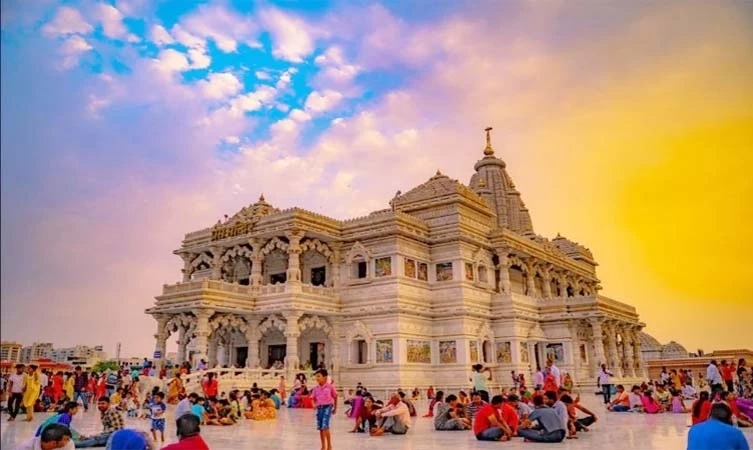The 12 Jyotirlingas hold immense significance in Hinduism, representing the sacred abodes of Lord Shiva. These revered lingams, which are naturally occurring or self-manifested, are spread across India and have captivating legends associated with their origin. Devotees embark on pilgrimages to these sites to seek the blessings of Lord Shiva and experience the divine aura surrounding these Jyotirlingas. In this comprehensive exploration, we will know about the stories, myths, and historical significance behind each of these 12 Jyotirlingas. We will provide you with information about the 12 Jyotirlinga tour package cost, enabling you to plan a convenient trip, whether with your family or solo.
Somnath
Located in Prabhas Patan near Veraval in Saurashtra, Gujarat, the Somnath Jyotirlinga is known as the "Protector of Moon." According to legend, Lord Krishna's grandson, King Somraj, built this temple. The story revolves around the moon god, Chandra, who was cursed to wane but later regained his luster after praying to Lord Shiva at this spot.
Mallikarjuna
Situated in the Nallamala Forest of Andhra Pradesh, the Mallikarjuna Jyotirlinga is associated with the divine romance of Lord Shiva and Goddess Parvati. The legend tells of Parvati's penance to win Shiva's love and their subsequent marriage at this sacred spot.
Mahakaleshwar
Located in Ujjain, Madhya Pradesh, the Mahakaleshwar Jyotirlinga is renowned for its unique form, a swayambhu (self-manifested) lingam. The legend narrates the tale of a fierce battle between Lord Shiva and the demon Dushana, ultimately leading to the establishment of the Jyotirlinga.
Omkareshwar
This temple is on the Mandhata Island in the Narmada River, Madhya Pradesh. Omkareshwar Jyotirlinga is associated with the story of a devout king, Mandhata, who pleased Lord Shiva with his devotion and received the Jyotirlingas blessings.
Kedarnath
Located in the Garhwal region of the Himalayas in Uttarakhand, Kedarnath Jyotirlinga is believed to be the place where Lord Shiva absolved himself from the guilt of killing the demon Gajasura. The temple is also part of the Char Dham Yatra.
Bhimashankar
Situated in Pune, Maharashtra, the Bhimashankar Jyotirlinga is linked to the tale of a demon named Bhima who troubled the sages. Lord Shiva appeared as Ardhanarishvara, a fusion of male and female energies, to defeat Bhima and protect the sages.
Kashi Vishwanath
The Kashi Vishwanath Jyotirlinga in Varanasi, Uttar Pradesh, is one of the most revered temples for Shiva devotees. The story revolves around Lord Shiva's battle with Lord Vishnu in the form of Varaha, ultimately leading to the manifestation of the Jyotirlinga.
Trimbakeshwar
Located near Nashik in Maharashtra, Trimbakeshwar Jyotirlinga is associated with the legend of Gautama Rishi and a cow named Kapila. Lord Shiva released the sacred Ganges river from his hair at this site, earning it the name "Trimbak."
Vaidyanath (Deoghar)
The Vaidyanath Jyotirlinga, situated in Deoghar, Jharkhand, is believed to have originated during the Treta Yuga. The story centers on the demon king Ravana, who sought to attain immortality through penance but was thwarted by Lord Shiva.
Nageshwar
Situated on the Dwarka Island in Gujarat, the Nageshwar Jyotirlinga is associated with a demon named Daruka, who captured a Shivalinga. Lord Shiva, in the form of a Jyotirlinga, defeated Daruka and reestablished the lingam at this site.
Rameshwar
Rameshwar Jyotirlinga, located on Rameswaram Island in Tamil Nadu, is associated with Lord Rama's quest to seek Lord Shiva's blessings before embarking on his mission to rescue Sita. Lord Rama built a lingam here and worshiped it as Ramanathaswamy.
Grishneshwar
The Grishneshwar Jyotirlinga, situated near Ellora Caves in Maharashtra, is linked to the story of a devout woman named Kusuma who revived her husband with Lord Shiva's blessings. This led to the establishment of the Grishneshwar temple.
Significance and Pilgrimage
Pilgrimage to the 12 Jyotirlingas is a sacred journey undertaken by countless devotees seeking spiritual solace and divine blessings. Visiting these temples is believed to purify the soul and provide respite from the cycle of birth and death. The twelve Jyotirlingas together represent the various aspects and forms of Lord Shiva, and their stories illustrate the triumph of good over evil and the significance of devotion.
Conclusion
The 12 Jyotirlingas are revered as the holiest shrines for Shiva devotees, each with its unique legend and significance. These sacred abodes symbolize the omnipresence of Lord Shiva across India and the divine connection between the creator and his devotees. Pilgrimage to these Jyotirlingas is a deeply spiritual experience, offering a chance for devotees to connect with the divine and find inner peace. The stories and myths behind each Jyotirlinga serve as a reminder of the enduring power of faith and devotion in the Hindu tradition.
For enquiries about 12 Jyotirlinga tour package costs, contact NTP group and plan your next trip in advance!


